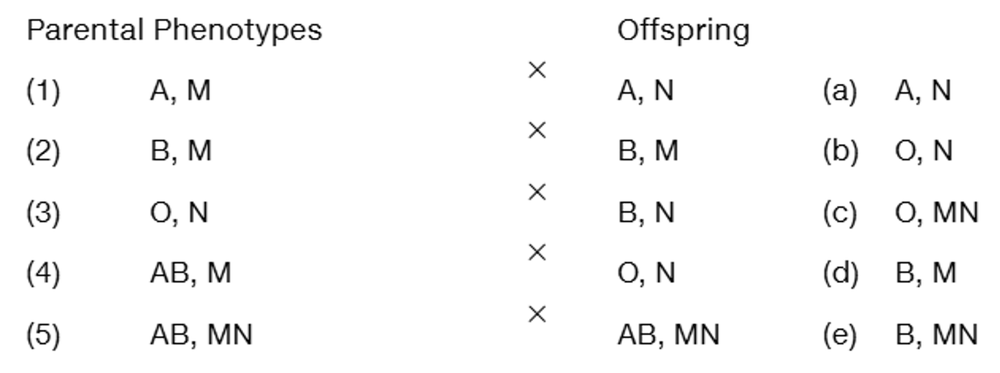Flower color in snapdragons results from the amount of the pigment anthocyanin in the petals. Red flowers are produced by plants that have full anthocyanin production, and ivory-colored flowers are produced by plants that lack the ability to produce anthocyanin. The allele An1 has full activity in anthocyanin production, and the allele An2 is a null allele. Dr. Ara B. Dopsis, a famous genetic researcher, crosses pure-breeding red snapdragons to pure-breeding ivory snapdragons and produces F₁ progeny plants that have pink flowers. He proposes that this outcome is the result of incomplete dominance, and he crosses the F₁ to test his hypothesis. What phenotypes does Dr. Dopsis predict will be found in the F₂, and in what proportions?
Table of contents
- 1. Introduction to Genetics51m
- 2. Mendel's Laws of Inheritance3h 37m
- 3. Extensions to Mendelian Inheritance2h 41m
- 4. Genetic Mapping and Linkage2h 28m
- 5. Genetics of Bacteria and Viruses1h 21m
- 6. Chromosomal Variation1h 48m
- 7. DNA and Chromosome Structure56m
- 8. DNA Replication1h 10m
- 9. Mitosis and Meiosis1h 34m
- 10. Transcription1h 0m
- 11. Translation58m
- 12. Gene Regulation in Prokaryotes1h 19m
- 13. Gene Regulation in Eukaryotes44m
- 14. Genetic Control of Development44m
- 15. Genomes and Genomics1h 50m
- 16. Transposable Elements47m
- 17. Mutation, Repair, and Recombination1h 6m
- 18. Molecular Genetic Tools19m
- 19. Cancer Genetics29m
- 20. Quantitative Genetics1h 26m
- 21. Population Genetics50m
- 22. Evolutionary Genetics29m
3. Extensions to Mendelian Inheritance
Variations of Dominance
Problem 22
Textbook Question
Five human matings (1–5), identified by both maternal and paternal phenotypes for ABO and MN blood-group antigen status, are shown on the left side of the following table:

Each mating resulted in one of the five offspring shown in the right-hand column (a–e). Match each offspring with one correct set of parents, using each parental set only once. Is there more than one set of correct answers?
 Verified step by step guidance
Verified step by step guidance1
Step 1: Understand the ABO and MN blood group inheritance. ABO blood groups are determined by the IA, IB, and i alleles. IA and IB are codominant, while i is recessive. MN blood groups are determined by the codominant alleles M and N, meaning an individual can be M, N, or MN.
Step 2: Analyze the parental phenotypes for each mating. For example, in mating (1), the parents are A, M x A, N. This means both parents have the A blood type (genotypes could be IAIA or IAi) and one parent is M (genotype MM) while the other is N (genotype NN).
Step 3: Determine the possible offspring for each mating based on the parental genotypes. For mating (1), the offspring could inherit IA from either parent and M or N from the respective parent, resulting in phenotypes such as A, M or A, N.
Step 4: Match the offspring phenotypes (a–e) to the parental matings (1–5). For example, if offspring (a) is A, N, it could only come from mating (1) because the parents have the A blood type and one parent has the N blood group.
Step 5: Check if there is more than one set of correct answers. Since the inheritance of ABO and MN blood groups follows specific genetic rules, there should be only one unique way to match each offspring to a parental set. Verify this by ensuring no offspring phenotype can be produced by more than one parental set.
 Verified video answer for a similar problem:
Verified video answer for a similar problem:This video solution was recommended by our tutors as helpful for the problem above
Video duration:
2mPlay a video:
Was this helpful?
Key Concepts
Here are the essential concepts you must grasp in order to answer the question correctly.
ABO Blood Group System
The ABO blood group system classifies human blood into four main types: A, B, AB, and O, based on the presence or absence of antigens on the surface of red blood cells. The inheritance of these blood types follows Mendelian genetics, where A and B are co-dominant alleles, while O is recessive. Understanding this system is crucial for predicting offspring blood types based on parental genotypes.
Recommended video:
Guided course

Variations on Dominance
MN Blood Group System
The MN blood group system is another example of codominance in human genetics, where individuals can have either M, N, or MN phenotypes based on the presence of specific antigens. Like the ABO system, the inheritance of MN blood types follows Mendelian principles, allowing for the prediction of offspring phenotypes from parental combinations. This concept is essential for analyzing the matings presented in the question.
Recommended video:
Guided course

Variations on Dominance
Punnett Square
A Punnett square is a diagram used in genetics to predict the genotypes of offspring from a cross between two parents. By organizing the possible gametes from each parent, it allows for a visual representation of genetic combinations and probabilities. Utilizing a Punnett square is key to solving the question, as it helps determine which parental combinations can produce the observed offspring phenotypes.
Recommended video:
Guided course

Chi Square Analysis

 4:37m
4:37mWatch next
Master Variations on Dominance with a bite sized video explanation from Kylia
Start learningRelated Videos
Related Practice
Textbook Question
370
views
